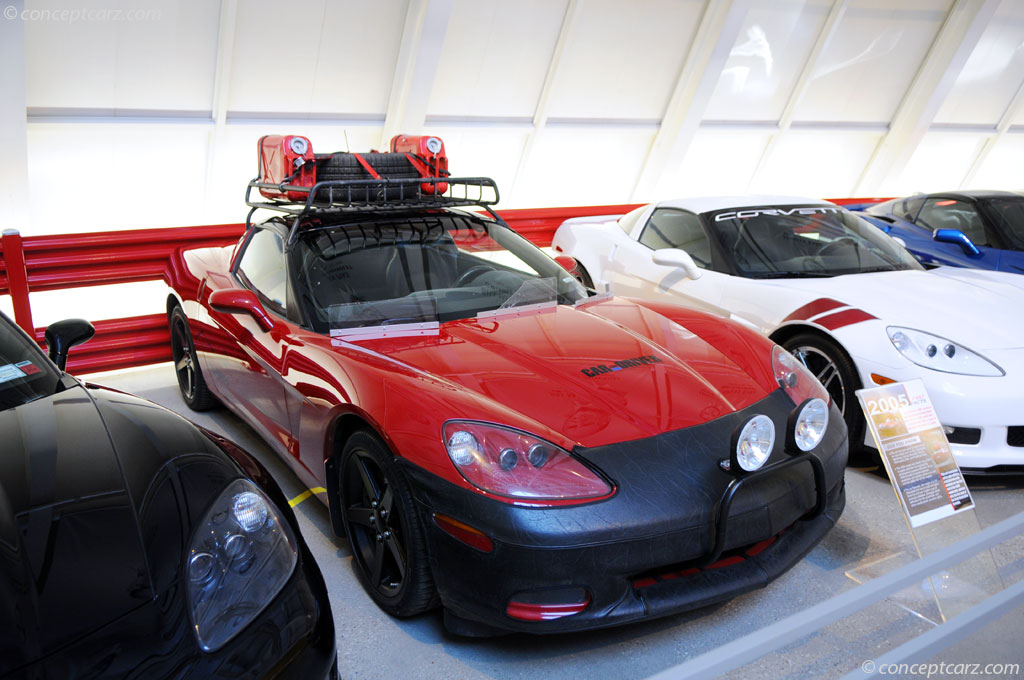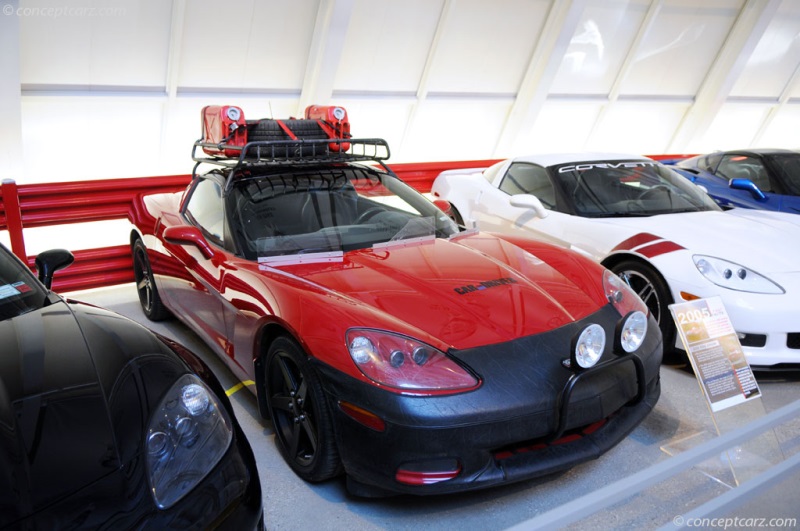Marking the sixth generation of its legacy, the 2005 Chevrolet Corvette delivers more power, passion and precision to reach a new standard of performance car excellence. It will be introduced at the North American International Auto Show in Detroit in January 2004, with production slated to begin in the third quarter. A convertible version will be unveiled in the first half of 2004, with its production beginning in fall 2004. The sixth generation Corvette blends technical sophistication with expressive style. Five inches shorter than the current car, the 2005 Corvette cuts a tighter, more taut profile - with virtually no loss of usable space. More than just visual, the new dimensions make the car more agile and tossable, with upgrades in handling, acceleration and braking. At 0.28 coefficient of drag, the C6 is the most aerodynamically efficient Corvette ever and has improved anti-lift characteristics that enable improved high-speed stability and confidence. Z51 Performance Package. The Z51 Performance Package brings Corvette Coupe performance very close to the same level as the widely admired Z06. The Z51 offers more aggressive dampers and springs, larger stabilizer bars, and larger, cross-drilled brake rotors for optimum track performance capability while still providing a well-controlled and comfortable ride. Extensive racetrack testing reveals that a C6 equipped with the Z51 suspension almost equals the lap time of a C5 Z06 - marking a major advance in the overall performance of a Corvette Coupe by nearly approximating the extreme performance capabilities of the vaunted Z06 at a remarkable value.LS2 PowertrainGM today announced the new 2005 Corvette will feature the most powerful standard engine ever in Corvette history: the 400 horsepower, 6.0-liter, small-block V-8. The new 6.0-liter LS2 is part of the fourth generation of GM's small-block engines. The small-block debuted in 1955 with 265 cubic inches and 195 horsepower. Since then, this legendary family of engines has been an integral component of Corvette's performance history. Compared to the Gen III-based LS1, the LS2 incorporates several significant changes that help improve performance, reliability and serviceability:-All-new aluminum block casting incorporates provisions for external knock sensors and revised oil galleries; external sensors improve serviceability
-Cylinder bore diameter increased to 101.6 mm (4.00 inches), increasing displacement to 6.0 liters
-Flat-top piston design with lower ring tension reduces friction
-Piston floating wrist pins help quiet the engine
-Revised exhaust manifolds are 33 percent lighter
-Compression raised to 10.9:1
-Engine redline raised to 6500 rpm
-Revised and more powerful engine mototronics incorporate all electronic throttle control functions. The Tremec T56 six-speed manual is standard and the Hydra-Matic 4L65-E four-speed automatic is optional.Corvette engineers thoroughly revised the Tremec gear box and added proprietary technology not offered on other automakers' high-performance transmissions. The six-speed transmission also has revised gearing when selected with the Z51 performance option. With the Z51, the Tremec is tailored with numerically higher gears to improve acceleration. Also, a lower fifth gear gives the Z51 better fuel efficiency and a higher top speed than base models. To increase durability in sustained high-speed situations, the Z51 and the base European manual-transmission models have a transmission cooler.The available automatic transmission in the C6 is the new Hydra-Matic 4L65-E four-speed. An upgraded version of the C5's 4L60-E, the L65 is strengthened and revised to accommodate the LS2's 400 lb.-ft. of torque. Suspension
CoupeCorvette C6 is the result of lessons learned from C5-R's successes on the track combined with fresh thinking about what a 21st century sports car should be. As the next logical step in the evolution of GM's Performance Cars Architecture, it takes its robust and real-world-validated backbone structure and enhances it with completely new suspension components. While the foundation has been enhanced, every suspension component that attaches to it has been changed - none of the suspension bits have been carried over from C5. The short-long arm and transverse leaf spring independent suspension design remains, but the control arms, springs, dampers, bushings, stabilizer bars, and steering gear are completely redesigned. The Extended Mobility Tires (EMT) are also new, taking advantage of the latest compound technology for run-flat capabilities, and play a critical role in the tuning of the suspension for maximum handling and a comfortable ride.Three suspension choices allow drivers to choose the setup that best suits their style of driving. Each of the choices (Corvette Standard, Magnetic Selective Ride Control, and Z51 Performance Package) provides outstanding handling, but each also offers drivers the ability to tailor the car's handling traits to specific preferences. 
CoupeThe Standard suspension is tuned for a balance of ride comfort and precise handling. The optional F55 Magnetic Selective Ride Control suspension adds to the Standard suspension magneto-rheological dampers that are able to detect road surfaces and adjust the damping rates to those surfaces almost instantly for optimal ride and body control. The optional Z51 Performance Package is a competition-ready system for the true performance enthusiast. It offers more aggressive dampers and springs, larger stabilizer bars, Goodyear Supercar tires with an asymmetrical tread pattern, and larger, cross-drilled brake rotors for outstanding handling performance that is still comfortable for daily driving. Beyond the suspension bits, the Z51 is a total system that takes the regular C6 to near-exotic levels of performance. It features gear ratios borrowed from the previous Corvette Z06 for maximum acceleration performance, and includes coolers added for the transmission and power steering systems for aggressive, track-oriented use. The result is a car that very nearly equals the Z06 in track performance - representing a tremendous value. Robust BrakesThe C6 brake system focuses its improvements chiefly on heat dissipation and durability requisite of the car's upgraded overall performance capability. For the Standard and F55 Magnetic Ride configurations, the brake rotors remain the same diameter as the C5, at 12.8 inches in front and 12.0 inches in the rear. However, the rotors themselves have been thoroughly redesigned. The front rotors weigh 2 pounds more than the C5, aiding durability. They also generate less heat against the brake pads, which improves wear and reduces fade. In all brake applications, the front calipers utilize dual pistons and the rears use single pistons. The Z51 Performance Package extends the Corvette's braking capability with larger diameter rotors (13.4 inches in front and 13.0 inches in rear) that are cross-drilled.Luxury
ConvertibleInterior materials are significantly upgraded for comfort and aesthetics. The instrument panel and doors are covered with cast-skin foam-in-place trim that is soft to the touch with low gloss to minimize glare. To the eye, it looks like a leather-wrapped, padded panel. To the touch, it is warm and inviting. This advanced material has double the life of conventional automotive paneling materials, resists fading and sun damage, and minimizes interior fogging, which can occur as plasticizers migrate out of the material. Aluminum trim plates with a woven-type tactile surface add richness and emphasize features.The traditional, easy-to-read analog gauges of C5 provided an excellent starting point for C6's designers to refine and enhance. White-on-black numerals inform the driver with clean, straightforward displays for speedometer, tachometer, oil pressure, water temperature, voltage, and fuel level. To reduce visual clutter, major telltales were moved from within the dominant tachometer and speedometer gauges to the area between them. A menu-selectable head-up display is projected onto the windshield in front of the driver with vehicle speed and other information. The display is focused so that it aligns with the driver's line of sight on the road ahead, allowing the driver to focus on driving while still being able to monitor vehicle speed and other critical vehicle information.
CoupeThere are two settings for the HUD: Street and Track; and each setting is preprogrammed to display information that is relevant for each respective - and very different - situation. In Street mode, the driver can select between several configurations that feature the speedometer and the turn signal indicators, and then add to it other information such as audio system data, automatic transmission gear position, and high-beam indicator. In Track mode, there is a larger tachometer, a speedometer, engine condition gauges, and a real-time lateral accelerometer that samples and displays the maximum g-force experienced during a turn. The HUD uses LCD pixels to construct the alphanumeric characters and graphics, allowing the HUD to change size and shape. The removable-roof panel is 15 percent larger, yet offers the same structural stiffness as C5's while weighing just one pound more. The roof panel comes standard painted body color, or is available with optional tinted clear or with a dual-roof package. With new indexing side-window glass and redesigned seals, Corvette is much more free from wind noise, too. And the many improvements in tires, suspension, and body structure yield impressive reductions in road noise, while improving overall quality perception and making long trips that much more pleasurable.Source - General Motors
-Cylinder bore diameter increased to 101.6 mm (4.00 inches), increasing displacement to 6.0 liters
-Flat-top piston design with lower ring tension reduces friction
-Piston floating wrist pins help quiet the engine
-Revised exhaust manifolds are 33 percent lighter
-Compression raised to 10.9:1
-Engine redline raised to 6500 rpm
-Revised and more powerful engine mototronics incorporate all electronic throttle control functions. The Tremec T56 six-speed manual is standard and the Hydra-Matic 4L65-E four-speed automatic is optional.Corvette engineers thoroughly revised the Tremec gear box and added proprietary technology not offered on other automakers' high-performance transmissions. The six-speed transmission also has revised gearing when selected with the Z51 performance option. With the Z51, the Tremec is tailored with numerically higher gears to improve acceleration. Also, a lower fifth gear gives the Z51 better fuel efficiency and a higher top speed than base models. To increase durability in sustained high-speed situations, the Z51 and the base European manual-transmission models have a transmission cooler.The available automatic transmission in the C6 is the new Hydra-Matic 4L65-E four-speed. An upgraded version of the C5's 4L60-E, the L65 is strengthened and revised to accommodate the LS2's 400 lb.-ft. of torque. Suspension
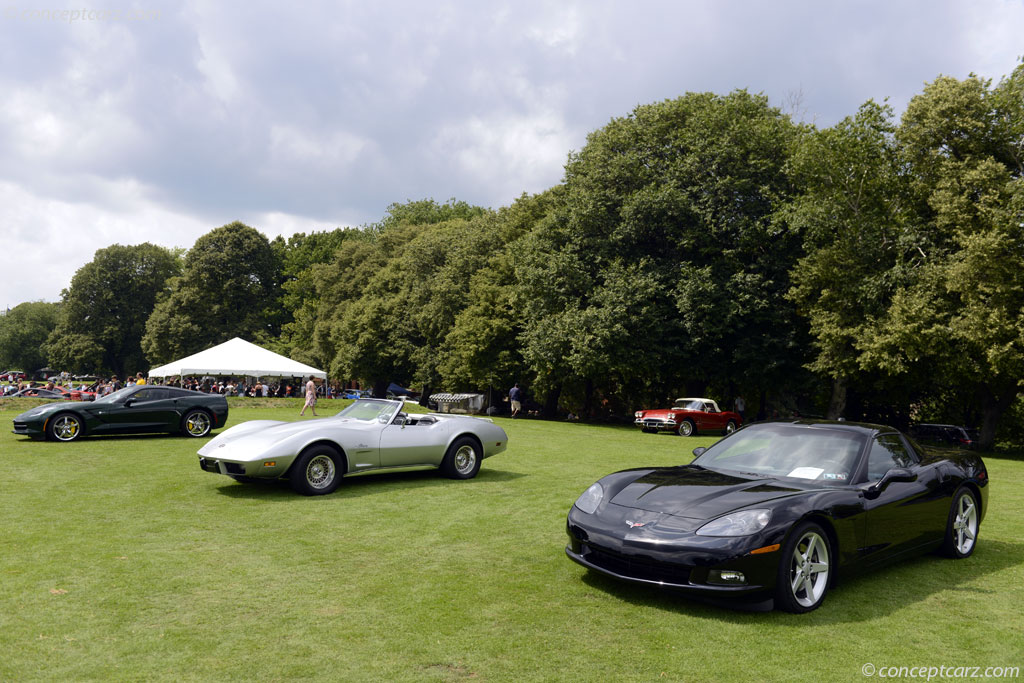
Coupe
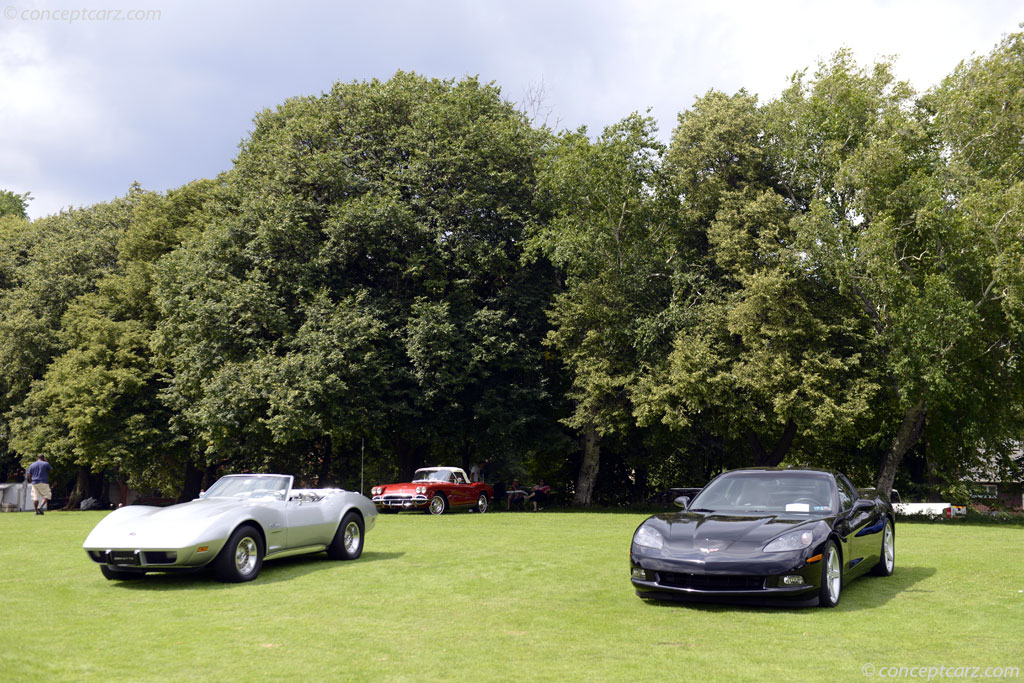
Coupe
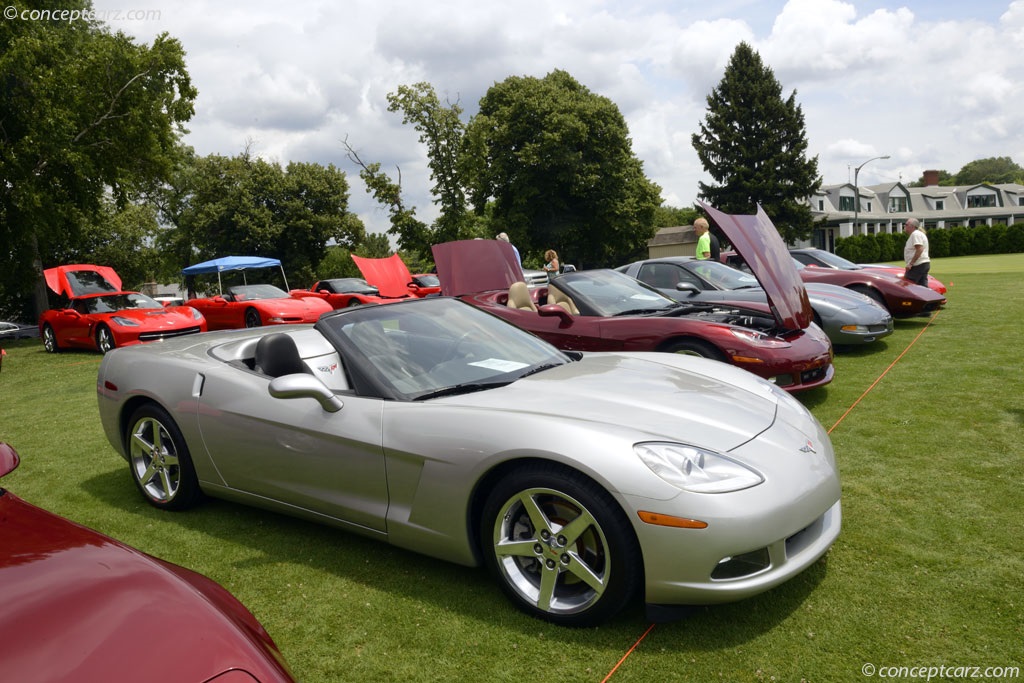
Convertible
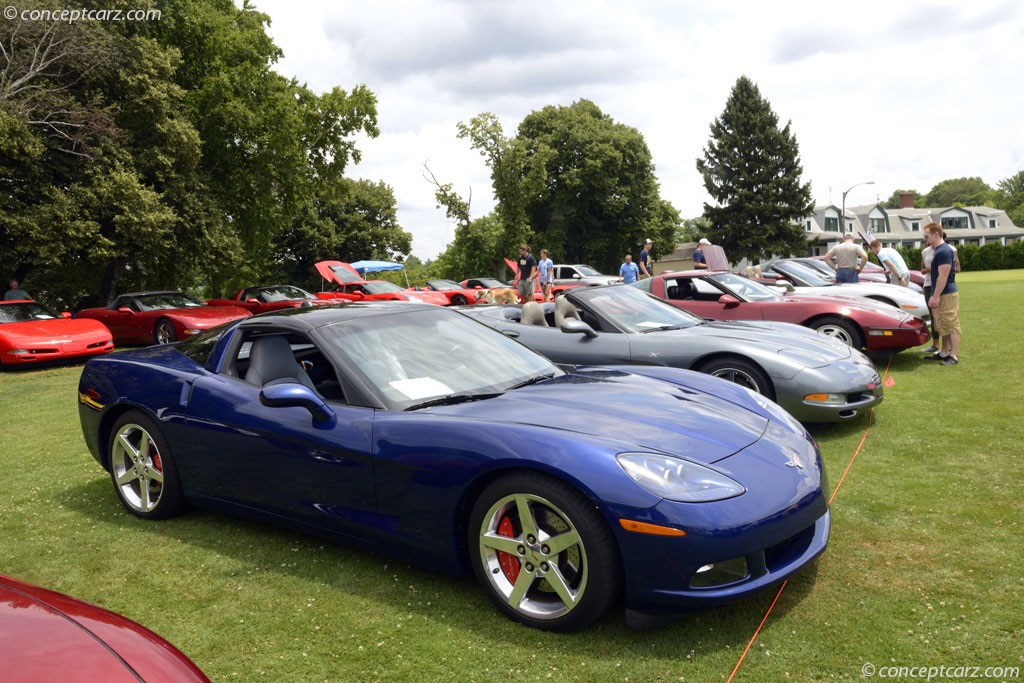
Coupe
It all started with a roadster. The thrill of open-air motoring was a part of the original allure when the Chevrolet Corvette was born in 1953. Now the sixth-generation 2005 Corvette Convertible arrives, bringing serious performance and thoughtful refinement to the fun of driving a roadster.
The sixth-generation of the Corvette legacy begins with the 2005 edition, available in Coupe and Convertible models. Featuring dramatic upgrades throughout, a new 400-horsepower, 6.0-liter V-8 engine, and dynamic new styling, the sixth-generation Corvette brings more power, passion and precision to America's performance icon. Production of the 2005 Corvette Convertible begins in fall 2004, slightly after the Coupe begins production in late summer. The 2005 Corvette will be available for sale in the U.S. in late summer, with sales in Europe scheduled to begin in October. 'We designed the Corvette from the outset as an open car, so there's no compromise in ride, handling and performance for the Convertible compared to the Coupe,' said Dave Hill, chief engineer for the Corvette and vehicle line executive for GM Performance Cars. 'This sixth-generation Convertible is a large step forward, featuring greatly improved function, appearance and quietness.'The sixth-generation Corvette Convertible features an optional power-operated soft top, a feature that last appeared on the car in 1962. The power top features a single-button control and completes its cycle in 18 seconds. The top is designed and manufactured in partnership between GM and Car Top Systems, Gmbh, experts who've contributed to some of the world's most celebrated open cars. An easy-to-operate manual top remains standard. The convertible top for the sixth-generation Corvette reflects great attention to detail to net improvements in aesthetics, aerodynamics and utility. In both its manual and power versions, the canvas soft top is available in three colors: Black, Beige and Grey. In its closed position, the canvas top has a smoother, more contoured appearance that conceals the underlying structure better than traditional soft tops. In addition to being more pleasing to the eye, this also helps preserve the outstanding aerodynamic characteristics designed into the sixth-generation Corvette. 'We sweated the details to ensure that the Convertible driver has all the performance of the Coupe, with surprising quietness and excellent storage capability for a roadster, top-up or top-down,' Hill said. Indexing side glass, a feature normally reserved for higher-priced luxury cars, helps better seal the cabin from wind noise. The Corvette's new structure, including a new aluminum windshield frame, was designed using extensive computer airflow models to improve top-down quietness – especially for noise frequencies in the range of passenger conversations. The top material itself is made of a thick fabric called Twillfast, constructed in five layers for strong durability and insulation. In addition to the new power top, several more details combine to make the convertible much more pleasing to drive, especially for long trips. A bulkhead has been added to better contain small items in the trunk and enable the addition of a new storage area behind each seat. The power top occupies no more space than the manual version, preserving maximum trunk space in both versions. Rear visibility is improved with a glass backlight that is 18.5 percent larger than the 2004 version. Like its predecessor, the backlight has a standard rear defogger. In an era in which most vehicles seem to grow ever more bulky, the sixth-generation Corvette achieves lower vehicle weight, even with the addition of numerous features new to the marque. The Convertible is no exception, with a base curb weight of 3,199 pounds (1,451 kg), 49 pounds (22 kg) less than the 2004 model. The manual top mechanism utilizes thin-wall castings for a weight savings of 8.6 pounds (3.9 kg.) The optional power top mechanism adds just 14 pounds (6.4 kg.) to the car's weight.Every option available on the Coupe can be had on the Convertible, including features new to the Corvette such as OnStar, XM Satellite Radio and DVD-Navigation. Likewise, all three suspension choices – Corvette Standard Suspension, Magnetic Selective Ride Control, and the new Z51 Performance Package – are available on the Convertible.Passionate performance
CoupeThe sixth-generation Corvette not only replaces the outgoing C5 Corvette (1997-2004), but also creates a 21st century Corvette that thrills the legions of traditional loyalists and captures the imagination of a new generation of performance enthusiasts. The formula from the C5 era remains: Extremely high performance capabilities in a car that offers great style, value and quality, with surprising comfort for daily driving. The new Corvette takes that foundation and reaches beyond with dramatic increases in performance and refinement, wrapped in a passionate new design.Thanks to an all-new chassis, strong and lightweight body structure and the new 400-horsepower LS2 engine, the 2005 Corvette again raises the bar for performance, with outstanding handling and surprising ride quality. Equipped with the new Z51 Performance Package, the 2005 Corvette (in both Coupe and Convertible body styles) nearly matches the track performance of today's widely respected Corvette Z06 model. The sixth-generation Corvette blends its technical sophistication with expressive style. Five inches shorter than the C5, the 2005 Corvette cuts a tighter, more taut profile – with virtually no loss of usable space. More than just visual, the new dimensions make the car more agile and 'toss-able,' with upgrades in handling, acceleration and braking. At 0.28 coefficient of drag, the sixth-generation car is the most aerodynamically efficient Corvette ever and has enhanced anti-lift characteristics that enable improved high-speed stability and confidence.Source - GM
The sixth-generation of the Corvette legacy begins with the 2005 edition, available in Coupe and Convertible models. Featuring dramatic upgrades throughout, a new 400-horsepower, 6.0-liter V-8 engine, and dynamic new styling, the sixth-generation Corvette brings more power, passion and precision to America's performance icon. Production of the 2005 Corvette Convertible begins in fall 2004, slightly after the Coupe begins production in late summer. The 2005 Corvette will be available for sale in the U.S. in late summer, with sales in Europe scheduled to begin in October. 'We designed the Corvette from the outset as an open car, so there's no compromise in ride, handling and performance for the Convertible compared to the Coupe,' said Dave Hill, chief engineer for the Corvette and vehicle line executive for GM Performance Cars. 'This sixth-generation Convertible is a large step forward, featuring greatly improved function, appearance and quietness.'The sixth-generation Corvette Convertible features an optional power-operated soft top, a feature that last appeared on the car in 1962. The power top features a single-button control and completes its cycle in 18 seconds. The top is designed and manufactured in partnership between GM and Car Top Systems, Gmbh, experts who've contributed to some of the world's most celebrated open cars. An easy-to-operate manual top remains standard. The convertible top for the sixth-generation Corvette reflects great attention to detail to net improvements in aesthetics, aerodynamics and utility. In both its manual and power versions, the canvas soft top is available in three colors: Black, Beige and Grey. In its closed position, the canvas top has a smoother, more contoured appearance that conceals the underlying structure better than traditional soft tops. In addition to being more pleasing to the eye, this also helps preserve the outstanding aerodynamic characteristics designed into the sixth-generation Corvette. 'We sweated the details to ensure that the Convertible driver has all the performance of the Coupe, with surprising quietness and excellent storage capability for a roadster, top-up or top-down,' Hill said. Indexing side glass, a feature normally reserved for higher-priced luxury cars, helps better seal the cabin from wind noise. The Corvette's new structure, including a new aluminum windshield frame, was designed using extensive computer airflow models to improve top-down quietness – especially for noise frequencies in the range of passenger conversations. The top material itself is made of a thick fabric called Twillfast, constructed in five layers for strong durability and insulation. In addition to the new power top, several more details combine to make the convertible much more pleasing to drive, especially for long trips. A bulkhead has been added to better contain small items in the trunk and enable the addition of a new storage area behind each seat. The power top occupies no more space than the manual version, preserving maximum trunk space in both versions. Rear visibility is improved with a glass backlight that is 18.5 percent larger than the 2004 version. Like its predecessor, the backlight has a standard rear defogger. In an era in which most vehicles seem to grow ever more bulky, the sixth-generation Corvette achieves lower vehicle weight, even with the addition of numerous features new to the marque. The Convertible is no exception, with a base curb weight of 3,199 pounds (1,451 kg), 49 pounds (22 kg) less than the 2004 model. The manual top mechanism utilizes thin-wall castings for a weight savings of 8.6 pounds (3.9 kg.) The optional power top mechanism adds just 14 pounds (6.4 kg.) to the car's weight.Every option available on the Coupe can be had on the Convertible, including features new to the Corvette such as OnStar, XM Satellite Radio and DVD-Navigation. Likewise, all three suspension choices – Corvette Standard Suspension, Magnetic Selective Ride Control, and the new Z51 Performance Package – are available on the Convertible.Passionate performance

Coupe
Customized vehicles run the gamut from mild to wild. This Competition Yellow 2005 Corvette coupe show vehicle tilts toward the wild end of the spectrum. Its graphics make a clear statement about this sixth-generation Corvette's performance. Along with a myriad of appearance-changing features, this Corvette introduces a number of high-performance components for the 2005 Corvette.Source - GM
The sixth-generation, all-new 2005 Corvette is already considered a benchmark performance vehicle. For the enthusiast, however, such a benchmark is just a starting point to build something even better. Special high-performance features produce an estimated 25-horsepower boost to the LS2 engine's normal 400-hp output. Added to this power are subtle styling features that put this Victory Red Corvette convertible on an even faster track.Source - GM
By winning every race in the 2004 season, the Corvette C5-R racing team wrapped up the most successful era in Corvette's 50-year racing history. In its five years, the C5-R racing program took 35 victories in 55 races, four American Le Mans Series championships and three double victories at the 24 Hours of Le Mans . The Z06 sparked the second half of the C5's life span with a Corvette model for the extreme performance enthusiast. Now, Team Corvette combines the numerous attributes of the sixth-generation Corvette with the technology and winning determination from the C5-R program to take the new Z06 to the next level in total performance. Chevrolet introduced the 2006 Corvette Z06 at the North American International Auto Show. It is the fastest, most powerful car ever offered by Chevrolet and General Motors. It is comprised of an unprecedented level of capability and technology, making it one of the greatest performance values on the market. And with an unmistakably muscular appearance, the '06 Z06 has a visual attitude that always looks ready to demonstrate Corvette's winning attitude to any challenger around the globe. 'The new Z06 is the dividend from competing so successfully in endurance racing,' said Dave Hill, Corvette's chief engineer. 'It combines the strong attributes of the new, sixth-generation Corvette with the spirit, technology and know-how from the race program to form an American supercar with outstanding credentials.' The new Z06 achieves 500 horsepower in an approximately 3130-pound (1419.7 kg) package and is expected to deliver 0-60 performance of less than 4 seconds, eclipse the quarter-mile in less than 12 seconds and deliver a top speed of more than 190 mph on a race track. The links between racing and the production Z06 are both direct and indirect, as the vehicle was developed in conjunction with the forthcoming C6-R racecar, but they boil down to the application of lessons that could only have been learned after countless laps of endurance racing – everything from suspension geometry to aerodynamics. What the engineers developed was a totally unique vehicle that has its own powertrain, body structure and chassis system which are distinct from other Corvette models. Previous Z06 models, from the original 1963 model to the 2001-04 editions, incorporated suspension and/or engine upgrades that complemented existing Corvette systems. Not surprisingly, the specs for the '06 read like the blueprint of a champion. They include: LS7 7.0-liter/427-cubic-inch Gen IV V-8 with lightweight reciprocating components
500 horsepower (373 kw) at6200 rpm
475 lb.-ft. of torque (657 Nm) at 4800 rpm
7000 rpm redline
Titanium connecting rods and intake valves
Dry-sump engine lubrication system
Engine hand-built at GM's new Performance Build Center
Aluminum body structure with one-piece hydroformed perimeter rails frame and magnesium front cradle
Fixed roof design optimizes body rigidity and aerodynamics
Carbon-fiber composite front fenders and front wheelhouses
Unique front fascia incorporating a larger grille, cold-air scoop and lower air splitter
Wide-body rear fenders and a unique rear spoiler incorporated with the CHMSL
Huge 14-inch (355-mm) cross-drilled front disc brakes with six-piston calipers and 13.4-inch (340-mm) cross-drilled rear rotors with four-piston calipers
18 x 9.5-inch front wheels with 275/35ZR18 tires and 19 x 12-inch rear wheels with 325/30ZR19 tires
3-inch-diameter exhaust with bi-mode mufflers and larger polished stainless steel tips
Engine, transmission and differential oil coolers; and steering cooler
Rear-mounted battery to improve weight distribution
Unique interior features including revised gauge cluster and lightweight two-tone seats with more aggressive bolsters
Curb weight of 3130 pounds / 1419.7 kg (estimated)
3 inches (76.2 mm) wider than other Corvette models
Vehicle developed simultaneously with C6-R racecar.
The features above are merely the highline points of the comprehensively designed Z06. What follows is a closer look at the vehicle's unique attributes. LS7 engine The all-new LS7 of the '06 Z06 reintroduces the 427-cubic-inch engine to the Corvette lineup. Unlike the previous 427 engine, which was a big-block design, the new 7.0-liter LS7 is a small-block V-8 – the largest-displacement small-block ever produced by GM and a tribute to its 50 years as a performance icon.
CoupeWith 500 horsepower and 475 lb.-ft. of torque, it also is the most powerful passenger car engine ever produced by Chevrolet and GM. The LS7 is easily identified under the hood by red engine covers with black lettering. The LS7 shares the same basic Gen IV V-8 architecture as the Corvette's 6.0-liter LS2, but the LS7 uses a different cylinder block casting with pressed-in steel cylinder liners to accommodate the engine's wide, 104.8-mm-wide cylinder bores; the LS2 has 101.6-mm bores. And when compared to the LS2, the LS7 also has a different front cover, oil pan, exhaust manifolds and cylinder heads. Internally, the LS7's reciprocating components make use of racing-derived lightweight technology, including titanium connecting rods and intake valves, to help boost horsepower and rpm capability. The rpm fuel shut-off limit is 7000 rpm. The LS7's specifications include: 
CoupeUnique cylinder block casting with large, 104.8-mm bores and pressed-in cylinder liners
Forged steel main bearing caps
Forged steel crankshaft
Titanium connecting rods with 101.6-mm stroke
Forged aluminum flat-top pistons
11.0:1 compression
Dry-sump oiling system
Camshaft with .591-inch lift
Racing-derived CNC-ported aluminum cylinder heads with titanium intake valves and sodium-filled exhaust valves
Titanium pushrods and valve springs
Low-restriction air intake system
Hydroformed exhaust headers with unique 'quad flow' collector flanges.
'In many ways, the LS7 is a racing engine in a street car,' said Dave Muscaro, assistant chief engineer of small-block V-8 for passenger cars. 'We've taken much of what we've learned over the years from the 7.0-liter C5-R racing program and instilled it here. There really has been nothing else like it offered in a GM production vehicle.' One of the clearest examples of the LS7's race-bred technology is its use of titanium connecting rods. They weigh just 480 grams apiece, almost 30 percent less than the rods in the LS2 V-8. Besides being lightweight, which enhances high-rpm performance and rpm range, titanium makes the rods extremely durable. The LS7's CNC-ported aluminum cylinder heads are all-new and designed to meet the high airflow demands of the engine's 7.0-liter displacement, as it ingests approximately 100 cubic feet more air per minute than the Corvette's 6.0-liter LS2 V-8 – an 18-percent increase in airflow. Consequently, a hydraulic roller camshaft with .591/.591-inch valve lift is used to allow plenty of air to circulate in and out of the engine. To ensure optimal, uninterrupted airflow, the LS7's heads have straight, tunnel-like intake runners. Very large by production-vehicle standards – even racing standards – they are designed to maintain fast airflow velocity, providing excellent torque at low rpm and exhilarating horsepower at high rpm. The heads feature 70-cc combustion chambers which are fed by huge, 56-mm-diameter titanium intake valves. The lightweight titanium valves weigh 21grams less than the stainless steel valves used in the LS2, despite the valve head having 22 percent more area. They are complemented by 41-mm sodium-filled exhaust valves, vs. 39.4-mm valves in the LS2. To accommodate the large valve face diameters, the heads' valve seats are siamesed; and, taken from experience with the engines of C5-R racecars, the LS7's valve angles are held at 12 degrees – versus 15 degrees for the LS2 – to enhance airflow through the ports. All LS7 engines are assembled by hand at GM Powertrain's new Performance Build Center in Wixom , Mich. The exacting standards to which they are built include deck-plate honing of the cylinders – a procedure normally associated with the building of racing engines and almost unheard of in a production-vehicle engine. Dry sump oiling system
ConvertibleThe LS7 has a dry-sump oiling system designed to keep the engine fully lubricated during the high cornering loads the Corvette Z06 is capable of producing. An engine compartment-mounted 8-quart reservoir delivers oil at a constant pressure to a conventional-style oil pump pick-up at the bottom of the engine. The pressurized oil feed keeps the oil pick-up continually immersed in oil at cornering loads exceeding 1 g. Oil circulates through the engine and down to the oil pan, where it is sent back to the reservoir via a scavenge pump. The large-capacity reservoir, combined with a high efficiency air-to-oil cooler, provides necessary engine oil cooling under the demands of the engine's power output. With the dry-sump system, oil is added to the engine via the reservoir tank – which includes the oil level dipstick. The LS7's dry-sump system was developed and tested on racetracks in the United States and Europe , including Germany 's famed Nürburgring. And while common in racing cars, the Corvette Z06 is one of just a handful of production vehicles – and the only production Corvette – to ever incorporate such a high-performance oiling system. Drivetrain 
CoupeThe Corvette Z06's powertrain and drivetrain systems are matched to the LS7's performance capability. The light, four-into-one headers discharge in to new, close-coupled catalytic converters and through to new 'bi-modal' mufflers. The mufflers each feature a vacuum-actuated outlet valve, which controls exhaust noise during low-load operation but opens for maximum power. At the rear of the LS7 engine, a single-mass flywheel and lightweight, high-capacity clutch channel torque to the rear transaxle. The six-speed manual transmission has been strengthened to handle the LS7's increased torque load. The transmission includes a pump which sends transmission fluid to the front radiator for cooling. Upon its return, the fluid removes additional heat from the differential lube before returning to the transmission. The M6 transmission connects to a limited-slip differential, with enlarged ring and pinion gears. Stronger axle half-shafts with tougher universal joints transmit power to the rear wheels. Body structure 
CoupeThe Z06 has a unique aluminum body structure for optimum stiffness and light weight for the fixed-roof bodystyle. Perimeter rails are one-piece hydroformed members featuring cast suspension nodes, which replace many welded steel components on other Corvette models. Other castings, stampings and extrusions are combined into the innovative structure with state-of-the-art manufacturing technologies. Advanced structural composites featuring carbon fiber are bonded to the aluminum structure. The wider front wheelhouses, for example, are carbon composites and the passenger compartment floors combine carbon-fiber skins with an ultra-lightweight balsa wood core. Chassis system 
Coupe
Chassis #: 1G1YY24U655133241The 2006 Corvette Z06 has a new magnesium cradle that serves as the attachment point for the engine and some front suspension components. Magnesium is lighter than aluminum yet incredibly strong. The magnesium cradle helps improve the front-to-rear weight distribution, as do carbon-fiber front fenders and wheelhouses. Engineers also moved the battery from underhood to a position in the rear cargo area, behind one of the rear wheels. 'This is an instance where the street car uses more advanced material than the racecar,' said Hill. 'We're constrained by rules to run the steel frame in the racecars, but we stretched to bring even more performance technology to the street for out customers.' The mass reductions are offset by some added performance enablers, including dry-sump lubrication, 3-inch (76.2-mm) exhaust with outlet valves, larger wheels and tires, more power brake and stiffer roll stabilizers. Suspension, brakes, wheels and tires The Z06 retains the 106-inch (2686-mm) wheelbase of other Corvette models, as well as the short-long arm suspension and transverse leaf spring design, but it rides on all-new wheels, tires, brakes, as well as its own rear spring and roll stabilizer. The firmer suspension works harmoniously with large 18 x 9.5-inch cast-spun aluminum wheels and 275/35ZR18 tires in the front, and 19 x 12-inch cast-spun aluminum wheels with 325/30ZR19 tires in the rear – the largest wheel-and-tire combination ever offered on a Corvette. The tires use the latest extended-mobility technology from Goodyear to provide a satisfactory ride, but still allow the vehicle to achieve lateral acceleration of more than 1 g. The extended-mobility tires eliminate the need – and weight – for a spare tire and jack or inflator kit, and reduce the chance of a sudden loss of handling capability. 'The Z06 enables the driver to turn excellent track lap times, but it also is quick to learn and is very forgiving for its performance level,' said Hill. 'We tested its capability around the world to ensure it will feel at home on any road or race track.' Complementing the suspension system and large rolling stock is an equally capable four-wheel disc brake system, consisting of 14-inch (355-mm) vented and cross-drilled front rotors and 13.4-inch (340-mm) vented and cross-drilled rear rotors. For comparison, the '05 Corvette has 12.8-inch (325-mm) front and 12-inch (305-mm) rear rotors, while the '05 Corvette with the Z51 has 13.4-inch (340-mm) and 13-inch (330-mm) rotors. The front rotors are acted upon by huge, red-painted six-piston calipers that use six individual brake pads. Individual brake pads are used because they deliver more equalized wear compared to what would otherwise be a pair of very long single-piece pads. For the rear brakes, four-piston calipers with four individual brake pads are used. A Delphi four-channel ABS system is used, as is a very competent active handling system – complete with a Competitive Driving mode. The large brakes bring an excellent level of stopping capability with the Z06, and with their four-wheel brake cooling, they provide excellent fade resistance and lining life during track duties. Distinct design The new Z06 has an unmistakable and aggressive appearance, with design cues that include: A wide front fascia with a large, forward-facing grille opening, a splitter along the bottom and 'Gurney lips' along the sides to provide aerodynamic downforce
A cold air scoop in front of the hood that integrates an air inlet system for the engine
The trailing edge of the front wheel opening is radiused to achieve improved drag, but protects the body finish with a tough molding, and a large air extractor is located behind the wheel
A fixed-roof bodystyle optimizes body rigidity and aerodynamics
Wider rear fenders with flares cover the massive rear tires and a brake cooling scoop in front of the wheels visually balances the fender extractor
A tall rear spoiler houses the CHMSL on the top of the rear fascia
10-spoke wheels
Four larger stainless steel exhaust outlets
New-design Z06 badging on the front fenders
While the function of the Z06's design is to move air efficiently over the body and reduce lift, the net effect is a car that looks like a weight lifter whose muscles are straining the seams of his shirt. 'The Z06 has been sculpted very carefully, with every element in its design serving a performance function,' said Hill. 'It also has a purposeful, menacing resemblance to the C6-R.' The aerodynamics of the Z06's exterior were shaped by the experiences of the Corvette racing program, where high-speed stability and cornering capability are paramount. And while the racecars use large rear wings, the Z06's elevated spoiler provides sufficient downforce to balance the road-worthy front splitter without adversely affecting aerodynamic drag. The Z06's Cd is .31. Uncompromising amenities For all its race-inspired functionality, the Z06 is designed to be a daily drivable high-performance vehicle. To that end, comfort and convenience are held to a very high standard. HID lighting, fog lamps, leather seating, dual-zone air conditioning, cabin air filtration and Head-Up Display (HUD) with track mode and g-meter are standard. The Z06 also has a revised gauge cluster that displays the Z06 logo on the 7000-redline tachometer and has a new readout on the oil pressure gauge to reflect the higher standard pressure of the dry-sump oiling system. And, like other 2006 Corvettes, the Z06 has a new, smaller-diameter three-spoke steering wheel that provides a more agile, performance-oriented feel. The seats feature two-tone leathering surfaces, with Z06-logo embroidery and contrasting stitching. Z06 options include a Bose audio system with an in-dash six-CD changer, polished wheels, a telescoping steering wheel, heated seats, side air bags, a navigation system with GPS, Homelink and XM Satellite Radio. But for all its comfort, engineers did sacrifice a few components in the quest for lower weight and higher performance: Side bolsters are fixed and more aggressive to better hold the driver when cornering and they weigh less than standard-model seats
Passenger seat features manual controls, saving the weight of a power-adjust motor
Acoustic package revised to reduce weight and allow more aural feedback of the powertrain
Production of the 2006 Corvette Z06 will begin in the second half of 2005 at the Bowling Green , Ky. , Assembly Plant.Source - GM
500 horsepower (373 kw) at6200 rpm
475 lb.-ft. of torque (657 Nm) at 4800 rpm
7000 rpm redline
Titanium connecting rods and intake valves
Dry-sump engine lubrication system
Engine hand-built at GM's new Performance Build Center
Aluminum body structure with one-piece hydroformed perimeter rails frame and magnesium front cradle
Fixed roof design optimizes body rigidity and aerodynamics
Carbon-fiber composite front fenders and front wheelhouses
Unique front fascia incorporating a larger grille, cold-air scoop and lower air splitter
Wide-body rear fenders and a unique rear spoiler incorporated with the CHMSL
Huge 14-inch (355-mm) cross-drilled front disc brakes with six-piston calipers and 13.4-inch (340-mm) cross-drilled rear rotors with four-piston calipers
18 x 9.5-inch front wheels with 275/35ZR18 tires and 19 x 12-inch rear wheels with 325/30ZR19 tires
3-inch-diameter exhaust with bi-mode mufflers and larger polished stainless steel tips
Engine, transmission and differential oil coolers; and steering cooler
Rear-mounted battery to improve weight distribution
Unique interior features including revised gauge cluster and lightweight two-tone seats with more aggressive bolsters
Curb weight of 3130 pounds / 1419.7 kg (estimated)
3 inches (76.2 mm) wider than other Corvette models
Vehicle developed simultaneously with C6-R racecar.
The features above are merely the highline points of the comprehensively designed Z06. What follows is a closer look at the vehicle's unique attributes. LS7 engine The all-new LS7 of the '06 Z06 reintroduces the 427-cubic-inch engine to the Corvette lineup. Unlike the previous 427 engine, which was a big-block design, the new 7.0-liter LS7 is a small-block V-8 – the largest-displacement small-block ever produced by GM and a tribute to its 50 years as a performance icon.

Coupe

Coupe
Forged steel main bearing caps
Forged steel crankshaft
Titanium connecting rods with 101.6-mm stroke
Forged aluminum flat-top pistons
11.0:1 compression
Dry-sump oiling system
Camshaft with .591-inch lift
Racing-derived CNC-ported aluminum cylinder heads with titanium intake valves and sodium-filled exhaust valves
Titanium pushrods and valve springs
Low-restriction air intake system
Hydroformed exhaust headers with unique 'quad flow' collector flanges.
'In many ways, the LS7 is a racing engine in a street car,' said Dave Muscaro, assistant chief engineer of small-block V-8 for passenger cars. 'We've taken much of what we've learned over the years from the 7.0-liter C5-R racing program and instilled it here. There really has been nothing else like it offered in a GM production vehicle.' One of the clearest examples of the LS7's race-bred technology is its use of titanium connecting rods. They weigh just 480 grams apiece, almost 30 percent less than the rods in the LS2 V-8. Besides being lightweight, which enhances high-rpm performance and rpm range, titanium makes the rods extremely durable. The LS7's CNC-ported aluminum cylinder heads are all-new and designed to meet the high airflow demands of the engine's 7.0-liter displacement, as it ingests approximately 100 cubic feet more air per minute than the Corvette's 6.0-liter LS2 V-8 – an 18-percent increase in airflow. Consequently, a hydraulic roller camshaft with .591/.591-inch valve lift is used to allow plenty of air to circulate in and out of the engine. To ensure optimal, uninterrupted airflow, the LS7's heads have straight, tunnel-like intake runners. Very large by production-vehicle standards – even racing standards – they are designed to maintain fast airflow velocity, providing excellent torque at low rpm and exhilarating horsepower at high rpm. The heads feature 70-cc combustion chambers which are fed by huge, 56-mm-diameter titanium intake valves. The lightweight titanium valves weigh 21grams less than the stainless steel valves used in the LS2, despite the valve head having 22 percent more area. They are complemented by 41-mm sodium-filled exhaust valves, vs. 39.4-mm valves in the LS2. To accommodate the large valve face diameters, the heads' valve seats are siamesed; and, taken from experience with the engines of C5-R racecars, the LS7's valve angles are held at 12 degrees – versus 15 degrees for the LS2 – to enhance airflow through the ports. All LS7 engines are assembled by hand at GM Powertrain's new Performance Build Center in Wixom , Mich. The exacting standards to which they are built include deck-plate honing of the cylinders – a procedure normally associated with the building of racing engines and almost unheard of in a production-vehicle engine. Dry sump oiling system

Convertible

Coupe
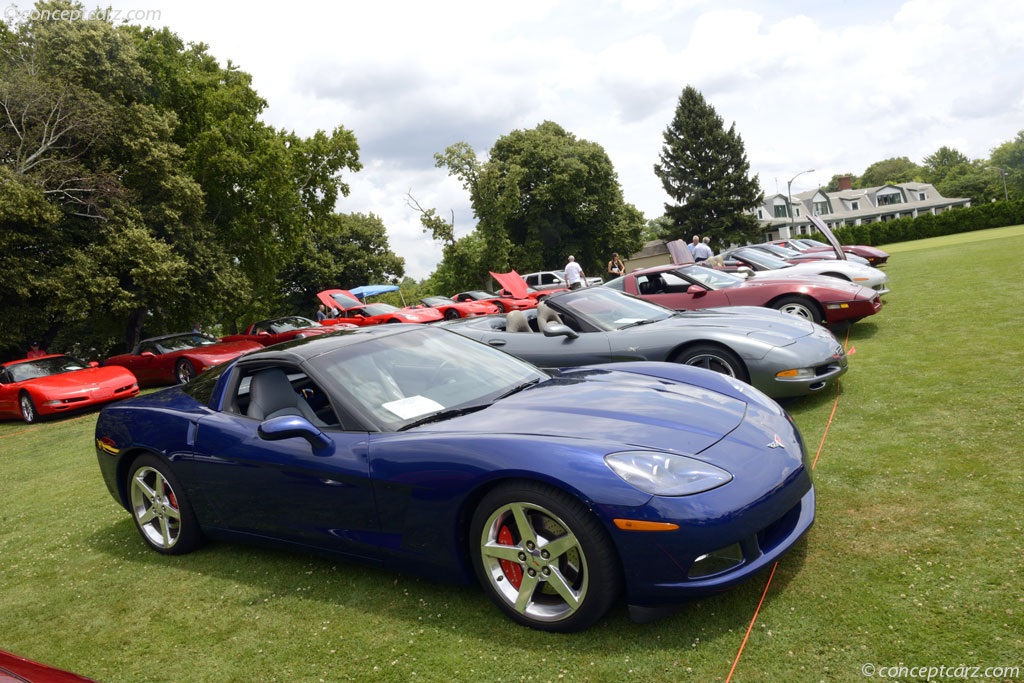
Coupe
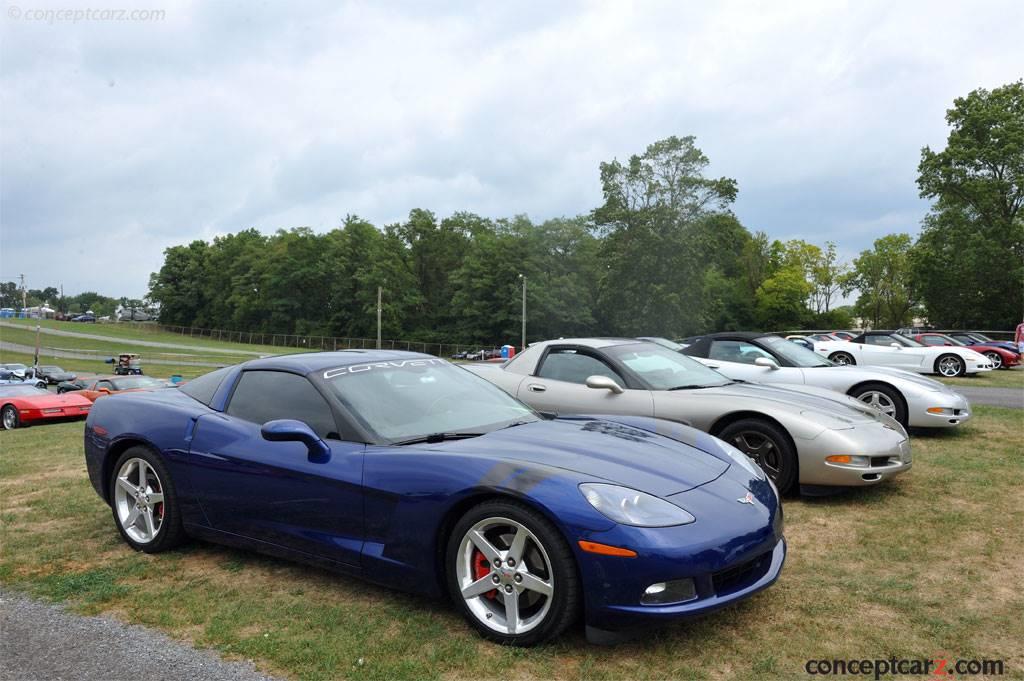
Coupe
Chassis #: 1G1YY24U655133241
A cold air scoop in front of the hood that integrates an air inlet system for the engine
The trailing edge of the front wheel opening is radiused to achieve improved drag, but protects the body finish with a tough molding, and a large air extractor is located behind the wheel
A fixed-roof bodystyle optimizes body rigidity and aerodynamics
Wider rear fenders with flares cover the massive rear tires and a brake cooling scoop in front of the wheels visually balances the fender extractor
A tall rear spoiler houses the CHMSL on the top of the rear fascia
10-spoke wheels
Four larger stainless steel exhaust outlets
New-design Z06 badging on the front fenders
While the function of the Z06's design is to move air efficiently over the body and reduce lift, the net effect is a car that looks like a weight lifter whose muscles are straining the seams of his shirt. 'The Z06 has been sculpted very carefully, with every element in its design serving a performance function,' said Hill. 'It also has a purposeful, menacing resemblance to the C6-R.' The aerodynamics of the Z06's exterior were shaped by the experiences of the Corvette racing program, where high-speed stability and cornering capability are paramount. And while the racecars use large rear wings, the Z06's elevated spoiler provides sufficient downforce to balance the road-worthy front splitter without adversely affecting aerodynamic drag. The Z06's Cd is .31. Uncompromising amenities For all its race-inspired functionality, the Z06 is designed to be a daily drivable high-performance vehicle. To that end, comfort and convenience are held to a very high standard. HID lighting, fog lamps, leather seating, dual-zone air conditioning, cabin air filtration and Head-Up Display (HUD) with track mode and g-meter are standard. The Z06 also has a revised gauge cluster that displays the Z06 logo on the 7000-redline tachometer and has a new readout on the oil pressure gauge to reflect the higher standard pressure of the dry-sump oiling system. And, like other 2006 Corvettes, the Z06 has a new, smaller-diameter three-spoke steering wheel that provides a more agile, performance-oriented feel. The seats feature two-tone leathering surfaces, with Z06-logo embroidery and contrasting stitching. Z06 options include a Bose audio system with an in-dash six-CD changer, polished wheels, a telescoping steering wheel, heated seats, side air bags, a navigation system with GPS, Homelink and XM Satellite Radio. But for all its comfort, engineers did sacrifice a few components in the quest for lower weight and higher performance: Side bolsters are fixed and more aggressive to better hold the driver when cornering and they weigh less than standard-model seats
Passenger seat features manual controls, saving the weight of a power-adjust motor
Acoustic package revised to reduce weight and allow more aural feedback of the powertrain
Production of the 2006 Corvette Z06 will begin in the second half of 2005 at the Bowling Green , Ky. , Assembly Plant.Source - GM
Related Reading : Chevrolet Corvette History
Very few vehicles elicit the same kind of satisfaction as the Chevrolet Corvette. The Vette is a symbol of childhood dreams and grown-up triumph. The only true American Sports car, this car stands for excellence and became an icon as a high-performance and dynamic sports vehicle. First introduced in January of 1953, the Corvette has only become more renowned as the years drift by. Undergoing many....
Continue Reading >>
Continue Reading >>
Chevrolet Corvette Roars Into Its 60th Year
On June 30, 1953, the first of a new kind of Chevrolet – indeed, a new kind of American car – rolled off an assembly line in Flint, Mich. The car had only two seats. There were no roll-up windows, or exterior door handles, for that matter. Its body wasnt stamped from steel but, rather, molded from reinforced fiberglass. While the postwar Baby Boom was in full swing, this was definitely not....
Continue Reading >>
Continue Reading >>
Corvette's Chassis Innovations Refined on the Race Track
Its been said that racing improves the breed, and when it comes to the Chevrolet Corvette, nearly six decades of checkered flags are the proof. As Corvette marks its 60th anniversary in 2013, the design of the chassis, suspension and other drivetrain features are rooted in the rigors of competition. Candidly, Corvette was not a high-performance car until Zora Arkus-Duntov fitted it with a V-8,....
Continue Reading >>
Continue Reading >>
Chevrolet puts a groove into your ride
Hot summer day… roof top down… wind in your hair … smile in your face… and Little Red Corvette cranked up to its loudest setting. Theres nothing like music in the car to make a journey really fly by. But, did you know that, aside from Princes classic hit, more than 600 songs across all genres and multiple generations mention Chevrolet, Chevy or the name of a Chevrolet vehicle in their....
Continue Reading >>
Continue Reading >>
Similarly Sized Vehicles
from 2005
Chevrolet Monthly Sales Volume
March 2023
398,141
2005 Chevrolet Corvette Vehicle Profiles
Recent Vehicle Additions
Performance and Specification Comparison
Price Comparison
$10,890
$15,730
$18,770
$19,080
$21,090
$21,740
$22,220
$22,810
$24,080
$25,040
$27,000
$34,170
$35,170
$36,025
$42,240
Related Automotive News

V-Series Blackwing: Ultimate Track Capability, Zero Compromise
The 2022 Cadillac CT4-V Blackwing and CT5-V Blackwing, two of the most powerful Cadillacs ever, raise the bar on performance
The 2022 Cadillac CT5-V Blackwing and CT4-V Blackwing represent the pinnacle of Cadillac performance and craftsmanship,...

The All-New BMW 1 Series
Sportier design, improved handling and agility.
Lower emissions, more power and improved fuel efficiency.
BMW Head-up display, BMW Digital Key, BMW Intelligent Personal Assistant and BMW Live Cockpit Plus.
Array of new driver assistant systems.
...

DODGE VIPER POWERS INTO 2016 WITH NEW ACR MODEL, EXPANDED CUSTOM OPTIONS AND INDUSTRY-EXCLUSIVE COLORS
New 2016 Dodge Viper ACR (American Club Racer) model returns fastest street legal Viper track car ever
New matte-finish exterior color options double the Vipers custom 1 of 1 exterior paint options to 16,000 colors and more than 50 million uniq...

NEW VOLKSWAGEN GOLF R MAKES ITS U.S. DEBUT AT THE 2014 NORTH AMERICAN INTERNATIONAL AUTO SHOW
Most powerful production Golf ever for the North American market
New car has an estimated 290 horsepower, but is more fuel efficient than previous Golf R
EA888 TSI® 2.0-liter engine propels DSG® equipped Golf R from 0 to 62 mph in 4.9 seconds
...

NEW VOLKSWAGEN GOLF R MAKES ITS U.S. DEBUT AT THE 2014 NORTH AMERICAN INTERNATIONAL AUTO SHOW
Most powerful production Golf ever for the North American market
New car has an estimated 290 horsepower, but is more fuel efficient than previous Golf R
EA888 TSI® 2.0-liter engine propels DSG® equipped Golf R from 0 to 62 mph in 4.9 seconds
Car...
